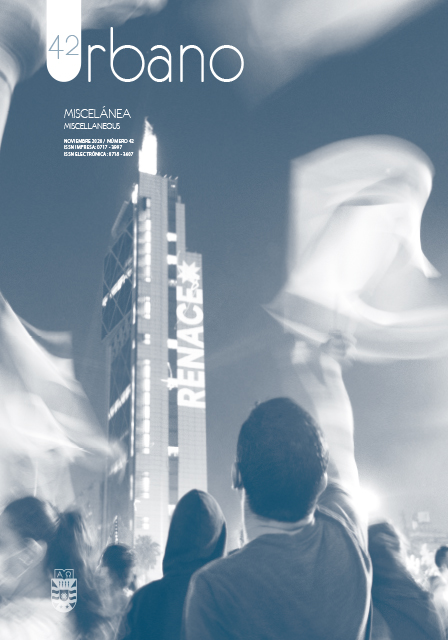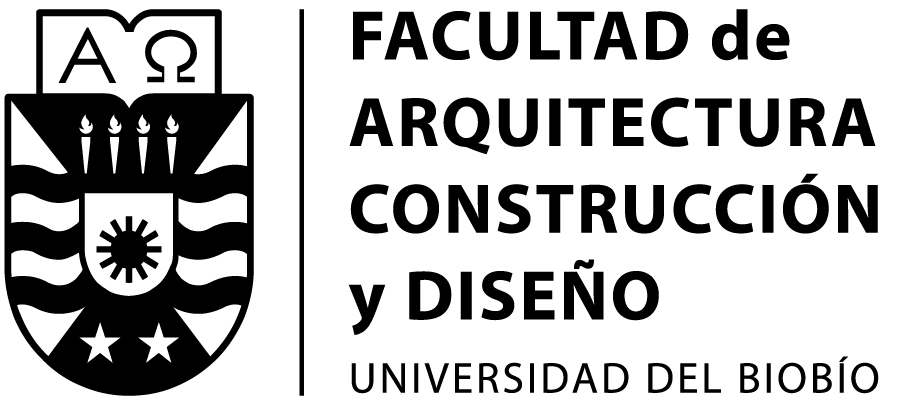Aplicación del método WUDAPT en la ciudad de Mendoza-Argentina para definir Zonas Climáticas Locales
DOI:
https://doi.org/10.22320/07183607.2020.23.42.02Palabras clave:
clima urbano, zonificación, LCZ, morfología urbana, Área Metropolitana de MendozaResumen
El trabajo aplica el modelo de Zonas Climáticas Locales en el Área Metropolitana de Mendoza -AMM- utilizando el método WUDAPT y realiza un análisis crítico de su factibilidad de implementación en función de las características de la ciudad. Como hipótesis, contar con una zonificación de las estructuras urbanas homologadas de acuerdo a su condición microclimática es el primer paso para efectivizar la implementación de distintas estrategias de mitigación de la isla de calor a escala ciudad. Las limitaciones del método WUDAPT (World Urban Database and Access Portal Tools) en el área de estudio se vinculan a dos factores: la definición de clases para la zonificación y la condición de homogeneidad necesaria para determinar las áreas de entrenamiento. Los resultados muestran, que la clasificación WUDAPT se estructura en clases puras, con imposibilidad de generar subclases. Las clases puras están definidas de acuerdo a la combinación de un conjunto de parámetros que no describen de manera acabada la condición de los perfiles urbanos del AMM en verano, donde el arbolado en alineación actúa como elemento morfológico estructurante. Esto implica la necesidad de generar subclases, afectando la relación entre Factor de Visión de Cielo, relación alto/ancho de canal vial, Factor de Ocupación de Suelo, superficie impermeable y altura promedio. Otra limitación, es el tamaño de las zonas de entrenamiento, que exige áreas homogéneas de 1 Km2, condición difícil de cumplir en el AMM. En este trabajo la herramienta con clases estándar ha sido adaptada para la apropiada caracterización de las zonas climáticas en ciudades con abundante forestación urbana, cuya tipología es creciente en América Latina. Se concluye que, superadas las limitaciones de la herramienta, las zonas climáticas identificadas dentro del área de análisis muestran correlación con el paisaje de los distintos sectores de la ciudad y homogeneidad térmica intraclase.
Descargas
Citas
Akbari H. y Konopacki S. (2004). Energy effects of heat-island reduction strategies in Toronto, Canada. Energy and Buildings, 29, 191-210. DOI:10.1016/j.energy.2003.09.004
Alchapar N. y Correa E. (2016) The use of reflective materials as a strategy for urban cooling in an arid “oasis” city. Sustainable Cities and Society, 27, 1-14. DOI: https://doi.org/10.1016/j.scs.2016.08.015.
Alchapar N., Correa E. y Cantón M. A. (2018). ¿Techos reflectivos o verdes? Influencia sobre el microclima en ciudades de zonas áridas. Mendoza-Argentina. Cuadernos de Vivienda y Urbanismo, 11(22) 1-23, DOI: https://doi.org/10.11144/Javeriana.cvu11-22.trvi
Arellano Ramos, B. y Roca Cladera, J. (2015). Planificación Urbana y Cambio Climático. En International Conference on Regional Science. XVI Reunión de Estudios Regionales. Centro de Política de Suelo y Valoraciones (CPSV). Universidad Politécnica de Cataluña, Barcelona, España, 18-20 noviembre.
Bechtel, B.; Alexander, P. J.; Böhner, J.; Ching, J.; Conrad, O.; Feddema, J.; Mills, G., … y Stewart, I. (2015). Mapping Local Climate Zones for a Worldwide Database of the Form and Function of Cities. International Journal of Geographic Information, 4(1), 199-219. DOI: https://doi.org/10.3390/ijgi401019
Castro Conrado, Y., Fernández Figueroa, E., Álvarez, A. y López, A. (2014). Morfología urbana en la ciudad de Sagua la Grande. Arquitectura y Urbanismo, 35(3), 50-68.
Correa, E. (2006). Isla de Calor Urbana. El Caso del Área Metropolitana de Mendoza. Tesis Doctoral. Universidad Nacional de Salta. Facultad de Ciencias Exactas.
Fernández García, F. y Martilli, A. (2016). Estudio de detalle del Clima Urbano De Madrid. https://www.madrid.es/UnidadesDescentralizadas/SostenibilidadEspeInf/EnergiayCC/04CambioClimatico/4cEstuClimaUrb/Ficheros/EstuClimaUrbaMadWeb2016.pdf
Flores Asin, J. E. (2019). Tecnologías verdes en zonas áridas. Diseño y evaluación energético-ambiental de sistemas de vegetación de aplicación en cubiertas edilicias. Tesis Doctoral. Universidad Nacional de Salta. Facultad de Ciencias Exactas Grimmond, C.S.B., Roth, M., Oke, T.R., Au, Y.C., Best, M., Betts, R. y Freitas, E.(2010). Climate and More Sustainable Cities: Climate Information for Improved Planning and Management of Cities. Procedia Environmental Sciences, 1, 247–274.
Hirano, Y. y Fujita, T. (2012). Evaluation of the impact of the urban heat island on residential and commercial energy consumption in Tokyo. Energy, 37(1), 371-383.
Linares, S. y Tisnés, A. (2011). Extracción y análisis de superficies urbanas construidas empleando imágenes Landsat 5 (TM). En I Congreso Nacional de Tecnologías de la Información Geográfica - IV Reunión de Usuarios de Tecnologías de la Información Geográfica del NEA (pp. 180-191). Facultad de Humanidades - UNNE, Laboratorio de Tecnologías de la Información Geográfica, IIGHI - CONICET. Resistencia, Corrientes, Argentina, 14-15 de abril.
Luber, G. y McGeehin, M. (2008). Climate change and extreme heat events. American Journal of Preventive Medicine, 35(5), 429-435. Martínez, C. F., Cantón, M. A. y Roig, F. A. (2014). Incidencia del déficit hídrico en el crecimiento de forestales de uso urbano en ciudades de zonas áridas. Caso de Mendoza, Argentina. Interciencia Revista de Ciencia y Tecnología de América, 39(12), 890-897.
Monteiro, V. (2018). Zonas Climáticas Locais E A Relação Com A Morfologia Urbana. Estudo de Caso: Campinas/Sp. Biblioteca Digital Pontificia Universidade de Campinas. Recuperado de http://tede.bibliotecadigital.puc-campinas.edu.br:8080/jspui/handle/tede/1047?mode=full
Palme, M., Inostroza, L., Villacreses, G., Lobato-Cordero, A. y Carrasco, C. (2017) From urban climate to energy consumption. Enhancing building performance simulation by including the urban heat island effect. Energy and Buildings, 145, 107-120. DOI: https://doi.org/10.1016/j.enbuild.2017.03.069
Pantavou, K., Theoharatos, G., Mavrakis, A. y Santamouris, M. (2011). Evaluating thermal comfort conditions and health responses during an extremely hot summer in Athens. Building and Environment, 46(2), 339-344. DOI:10.1016/j.buildenv.2010.07.026.
Pezzuto, C. y Silva, J. M. P. (2013). Métodos de Análisis del Recorte Territorial por medio de la Zona Climática Local y Unidad de Paisaje: Estudio de Caso en el Municipio de Campinas. En XII ENCAC. Brasilia, Brasil. 25-27 Setembro. Recuperado de http://antac.pcc.usp.br/eventos/encac-elacac-2013
Piccone, N. (2014). Clima Urbano de la ciudad de Tandil. Tesis Doctoral. Universidad Nacional de Sur. Departamento de Geografía y Turismo. DOI:10.13140/RG.2.1.2083.8808
Puliafito, S., Bochaca, F., Allende, D. y Fernández, R. (2013). Green áreas and microscale thermal comfort in arid environments: A case study in Mendoza, Argentina. Atmospheric and Climate Sciences, 3(03), 372–384.
Roca, G., Puliafito, S., Allende, D., Ruggieri, F. y Pascual, R. (2016). Modelado urbano a microescala: contribución al confort urbano de ecosistemas áridos. Revista AVERMA, (4), 01.77-01.88.
Ruiz, M.A. (2013). Efectos microclimáticos de la vegetación en ciudades de zonas áridas. Incidencia sobre los consumos energéticos y la calidad ambiental del hábitat. Tesis Doctoral. Universidad Nacional de Salta. Facultad de Ciencias Exactas.
Ruiz, M.A., Sosa, M.B., Correa, E.N. y Cantón, M.A. (2015). Suitable configurations of forested urban canyons to mitigate the UHI in Mendoza city, Argentina. Urban Climate, 14, 197-212. DOI: https://doi.org/10.1016/j.uclim.2015.05.005
Sakka, A., Santamouris, M., Livada, I., Nicols, F. y Wilson, M. (2012). On the thermal performance of low income housing during heat waves. Energy and Buildings, 49, 69-77. DOI: https://doi.org/10.1016/j.enbuild.2012.01.023.
Salvati, A., Palme, M. y De la Barrera, F. (2018). Urban morphology parametrization for climate modelling in urban planning. En 10th International Conference on Urban Climate/14th Symposium on the Urban Environment. 6-10
August 2018. New York, USA. Recuperado de https://www.ametsoc.org/index.cfm/ams/meetings-events/ams-meetings/10th-international-conference-onurban-climate-14th-symposium-on-the-urban-environment/
Santamouris, M., Cartalis, C., Synnefa, A. y Kolokotsa, D. (2015). On the impact of urban heat island and global warming on the power demand and electricity consumption of buildings—A review. Energy and Buildings, 98, 119-124. DOI: https://doi.org/10.1016/j.enbuild.2014.09.052.
Sarrat, C., Lemonsu, A., Masson, V. y Guedalia, D. (2006). Impact of urban heat island on regional atmospheric pollution. Atmos Environ, 40, 1743-1758. DOI: https://doi.org/10.1016/j.atmosenv.2005.11.037
Sosa, M.B (2018). Estrategias de mitigación de la isla de calor sustentabilidad ambiental y eficiencia energética de perfiles urbanos de baja densidad en zonas áridas. Tesis Doctoral. Universidad Nacional de Salta. Facultad de Ciencias
Exactas.
Sosa, M.B., Correa, E. y Cantón, M. A. (2018). Neighborhood Designs For Low Density Social Housing Energy Efficiency. A Study For An Arid City In Argentina. Energy and Building, 168, 137-146. DOI: https://doi.org/10.1016/j.enbuild.2018.03.006
Stewart, I. D. y Oke, T. R. (2012). Local climate zones for urban temperature studies. Bulletin of the American Meteorological Society, 93(12), 1879-1900.
Stewart, I. D., Oke, T. R. y Krayenhoff, E. S. (2014). Evaluation of the local climate zone scheme using temperature observations and model simulations. International Journal of Climatology, 34 (4), 1062-1080. DOI: https://doi.org/10.1002/joc.3746
Stocco, S. (2016). Impacto de la morfología y materialidad de las plazas en la calidad energético-ambiental de ciudades emplazadas en zonas áridas. Tesis Doctoral. Universidad Tecnológica Nacional (regional Mendoza) UTN.
Taha, H. (2008). Meso-urban meteorological and photochemical modeling of heat island mitigation. Atmospheric Environment, 42(38), 8795-8809. DOI: https://doi.org/10.1016/j.atmosenv.2008.06.036
Villalba, R., Boninsegna, J.A., Masiokas, M.H., Cara, L., Salomon, M., Pozzoli, P. (2016). Cambios Climáticos y Recursos Hídricos: El caso de las tierras secas del oeste argentino. Ciencia Hoy, 45, 49-55.
Wang, C., Ariane, M., Myint, S., Kapla, S., Brazel, A.J. y Lukasczyk, J. (2018). Assessing local climate zones in arid cities: The case of Phoenix, Arizona and Las Vegas, Nevada. Journal of Photogram and Remote Sensing, 141, 59-71. DOI: https://doi.org/10.1016/j.isprsjprs.2018.04.009
Descargas
Publicado
Cómo citar
Número
Sección
Licencia
Derechos de autor 2020 María Florencia Colli, Érica Norma Correa, Claudia Fernanda Martinez

Esta obra está bajo una licencia internacional Creative Commons Atribución-CompartirIgual 4.0.
El contenido de los artículos y reseñas que se publican en cada número de Urbano, es responsabilidad exclusiva de los autores y no representan necesariamente el pensamiento ni comprometen la opinión de la Universidad del Bío-Bío.
Las/os autoras/es conservarán sus derechos de autor, sin embargo, garantizarán a la revista el derecho de primera publicación y difusión de su obra. La publicación del artículo en Urbano estará sujeta a la Licencia de Reconocimiento de Creative Commons CC BY-SA que permite a otros compartir-copiar, transformar o crear nuevo material a partir de esta obra para cualquier propósito, incluso comercialmente, siempre y cuando se reconozcan la autoría y la primera publicación en esta revista, y sus nuevas creaciones estén bajo una licencia con los mismos términos.![]()























